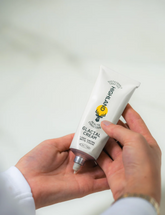
What Ingredients to Avoid in Shampoo (and What to Use Instead)
Think your shampoo is safe? Think again. We believe there is a big problem of hidden toxins in many conventional shampoos.
Over 40% of shampoos contain PFAS (forever chemicals)
—plus sulfates, parabens, and other junk that strip natural oils, irritate your scalp, and could mess with your hormones.
If you’ve ever dealt with:
- Greasy roots hours after washing
- Dry, irritated scalp that feels tight or itchy
- Hair thinning or breakage with no clear cause
…your shampoo might be the problem.
What Shampoo Ingredients You Should Avoid
If you see these on the label, put the bottle back.
| Ingredient | Why It’s Bad |
|---|---|
| Sulfates (SLS, SLES, Sodium Laureth Sulfate) | Strips natural oils, can cause dryness and irritation. |
| Parabens (e.g., Methylparaben) | Linked to hormone disruption and long-term health concerns. |
| Formaldehyde Releasers (e.g., DMDM Hydantoin) | Can release formaldehyde, a known carcinogen. |
| Phthalates | May interfere with hormone function; often hidden under “fragrance.” |
| Synthetic Fragrances | Catch-all term for potentially hundreds of unknown chemicals. |
| Silicones (e.g., Dimethicone) | Coat hair with synthetic shine, causing buildup over time. |
| Alcohol (Short-chain types like isopropyl alcohol) | Can dry out hair and irritate sensitive scalps. |
| Polyethylene Glycol (PEGs) | Can be contaminated with carcinogenic impurities like 1,4-dioxane. |
| Retinyl Palmitate | May cause skin sensitivity; linked to phototoxicity. |
| Sodium Chloride | Used as a thickener but may dry out scalp and disrupt hair treatments. |
| Diethanolamine (DEA) | Can react with other ingredients to form carcinogenic compounds. |
| Mineral Oil | Occlusive; can clog pores and trap dirt or bacteria on the scalp. |
| Urea | May release formaldehyde and cause irritation in sensitive users. |
| Cocamidopropyl Betaine | Derived from coconut but often contaminated with irritants. |
| Triclosan | Linked to antibiotic resistance and endocrine disruption. |
| Synthetic Colors | Often derived from coal tar and may cause allergic reactions. |
| Propylene Glycol | Can cause scalp irritation and allergic reactions in sensitive users. |
| Sodium Hydroxymethylglycinate | Preservative that may release formaldehyde over time. |
| PFAS (“Forever Chemicals”) | Persist in the body and environment; linked to serious health risks. |
The Solution: What to Look for Instead
Swap out toxic formulas for these clean, scalp-friendly ingredients:
Use This Instead |
Why It’s Better |
Aloe Vera & Coconut-Based Cleansers |
Gently cleanse without stripping. |
Botanical Extracts (Green Tea, Peppermint) |
Soothe the scalp and reduce irritation. |
Natural Emollients (Shea Butter, Jojoba Oil) |
Moisturize without clogging pores or causing buildup. |
Pro Tip: Look for sulfate-free, pH-balanced, and toxin-free formulas—like The Wash.
The Wash: No Toxins. No Transition Phase. Just Results.
Not all “clean” shampoos actually work. The Wash does.
❌ Toxins The Wash Leaves Out:
• No sulfates (SLS, SLES, sodium laureth sulfate)
• No parabens (including methylparaben)
• No formaldehyde-releasing preservatives (e.g., DMDM hydantoin, sodium hydroxymethylglycinate)
• No phthalates
• No synthetic fragrances or undisclosed “fragrance” ingredients
• No silicones (like dimethicone)
• No polyethylene glycol (PEGs)
• No mineral oil
• No triclosan
• No DEA, MEA, TEA, or other amine-based emulsifiers
• No synthetic dyes or colors
• No propylene glycol
• No PFAS (‘forever chemicals’)
✅ What The Wash Uses Instead:
• Botanical cleansers (derived from coconut, not cocamidopropyl betaine)
• Plant-based emollients for moisture without buildup
• Essential oils for scent, not synthetic perfumes
• pH-balanced formula to support a healthy scalp
• No transition phase or greasy adjustment period
• 100% ingredient transparency
Highland Style Co. formulated The Wash specifically to avoid these exact red-flag ingredients—no greenwashing, no hidden junk. Just clean, effective, scalp-safe performance from day one.
Why Do Brands Still Use These? (And How They Trick You)
- Cheap Fillers = More Profit – Sulfates = more lather, less cost. Silicones = fake shine.
- Greenwashing Marketing – Slapping “natural” or “organic” on the bottle doesn’t mean it's safe.
- Confusing Labels – Ever seen a 20+ ingredient list that sounds like a chemistry textbook? That’s on purpose.
FAQs
Will switching to a sulfate-free wash make my hair greasy?
Not with The Wash. It’s pH-balanced, so there’s no transition phase.
Does shampoo need to lather to clean effectively?
No—lather doesn’t equal clean. The Wash uses gentle botanical cleansers that clean deeply without harsh suds.
How do I know if my current shampoo is toxic?
Check the label for sulfates, parabens, or any chemical names you can’t pronounce.
What ingredients make a good shampoo?
Look for sulfate-free, pH-balanced formulas with botanical cleansers and natural moisturizers like aloe, jojoba, or shea butter.
What chemical in shampoo contributes to hair loss?
Sulfates, parabens, and formaldehyde-releasing preservatives can irritate the scalp and contribute to hair thinning or loss.





